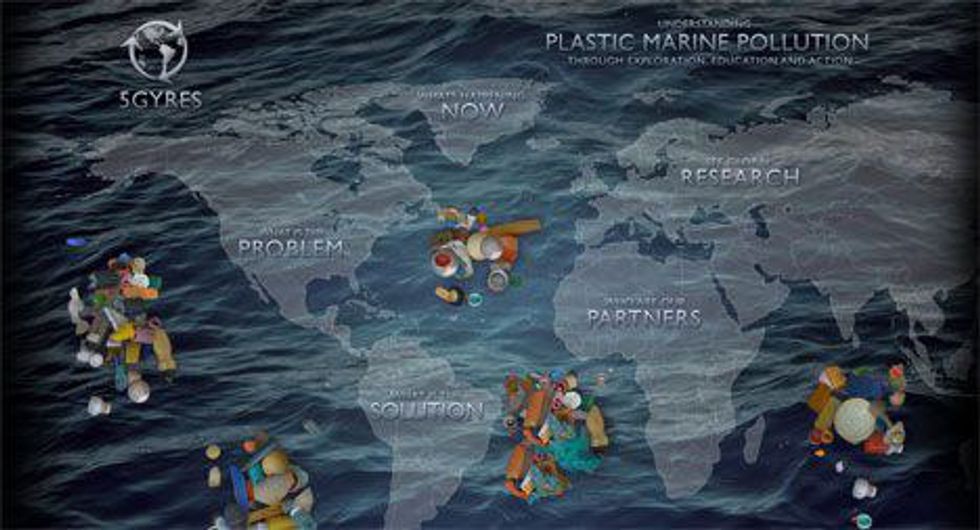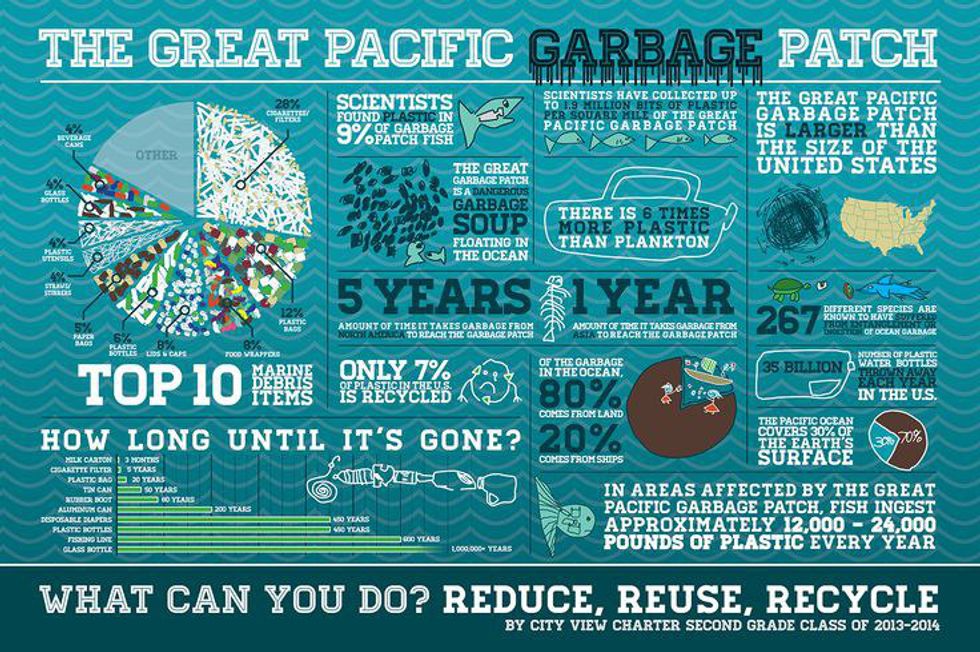An ocean gyre is a large system of circular ocean currents formed by global wind patterns and forces of Earth's rotation. There are five major ocean gyres in the world, and although they are naturally occurring phenomena, they are full of an unnatural substance: plastic.
Plastic trash is directly thrown or washed by heavy rains and rivers into the ocean. Approximately 80 percent of this pollution originates on land, and 20 percent is produced from recreational boaters, commercial operations, and maritime industries out in the ocean. It becomes swept up in the currents and is pushed toward the gigantic swirling vortexes known as the North Atlantic, South Atlantic, North Pacific, South Pacific, or Indian Ocean gyres. An estimated eleven million tons (and growing) of floating plastic covers an area of nearly five million square miles in the Pacific Ocean, 700 miles northeast of the Hawaiian Islands and 1000 miles off the coast of California. Once this trash enters the gyre, it is trapped and unable to get out. Since plastic is a petroleum-based, chemical compound, it is totally insoluble in water. However, it is photo-degradable, so when it is exposed to sunlight, it will continue to break down into smaller and smaller pieces. It soon makes its way to the center of the gyre where it continues to swirl and break down, where it finally turns into a toxic “plastic soup.”
Before making it to the middle of the gyre, animals such as sea turtles, whales, and birds consume large bits of plastic mistaking it for food. These big fragments cannot pass through the animals’ digestive systems and have no nutritional value. Without any room left for normal food, they slowly starve to death. Once an animal dies and its body decomposes, all that remains is the plastic, which is then released back into the environment to cause even more harm. They can also become entangled or trapped in plastic waste which can suffocate them. Small marine creatures also consume the small fragments of chemical-laden plastic, mistaking them for phytoplankton. Toxic compounds build up in these organisms faster than they can be broken down, which is called bio-accumulation, thus impacting the food chain from the bottom up. Ultimately, these harmful substances wind up in the seafood on our dinner plates and we thereby become subject to bio-accumulation ourselves.
Currently, we only recover about 5-10 percent of the plastics we produce. Approximately 50% are buried in landfills, and some are remade into durable goods, but much of it washes out to sea. So, what can you do to help? First and foremost, do not litter. It sounds like such an obvious thing, but remember that time you accidentally dropped that plastic straw wrapper or the cap to your bottle and said, “Oh well” and walked away. We are all guilty, but next time it happens, rethink the consequences, and then bend down to pick it up. Also, if you’re out and about, and you see someone else’s trash on the ground, take a second and just a small fraction of effort to pick it up, because you could be saving an animal’s life, and the ocean, just by cleaning up the world around you. Next, just reduce, reuse, and recycle. It is simple and just as easy as throwing it away, but you’ll be saving the world, our oceans, animals, and others around you. Additionally, it is important to educate your friends and family and spread the word to others to take action and protect the ocean.
Hundreds of ocean species are threatened by plastic pollution, as well as the survival of the ocean itself. Humans depend on the ocean for food and as a healthy ecosystem that maintains the balance of oxygen and carbon dioxide in the air. Science proves that if the ocean dies, we will quickly follow. So, what will you do to make a difference?




















